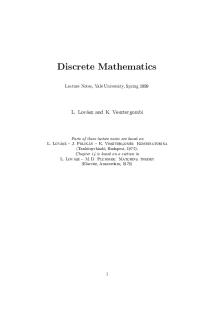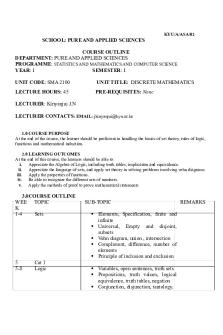Discrete Mathematics - Lecture 1.7 Introduction to Proofs PDF

| Title | Discrete Mathematics - Lecture 1.7 Introduction to Proofs |
|---|---|
| Course | Discrete Mathematics |
| Institution | University of Houston |
| Pages | 6 |
| File Size | 808.3 KB |
| File Type | |
| Total Downloads | 37 |
| Total Views | 132 |
Summary
Discrete Mathematics - Lecture 1.7 Introduction to Proofs...
Description
Math 3336 Section 1.7 Introduction to Proofs Topics:
Mathematical Proofs Forms of Theorems Direct Proofs Indirect Proofs Proof of the Contrapositive Proof by Contradiction Mistakes in Proofs
Definition: A
is a statement that can be shown to be true.
We demonstrate that a theorem is true with a proof (valid argument) using: • Definitions • Other theorems • Rules of Inference • Axioms •
A
a ‘helping theorem’ or a result which is needed to prove a theorem.
•
A
•
Less important theorems are sometimes
.
•
A
e. Once a proof of a conjecture
y is a result which follows directly from a theorem.
is a statement that is being
is found, it becomes a theorem. It may turn out to be false.
Forms of Theorems • Many theorems assert that a property holds for all elements in a such as the integers, the real numbers, or some of the discrete structures that we will study in this class. • Often the universal quantifier (needed for a precise statement of a theorem) is omitted by standard mathematical convention. Example: then 2 > 2 ”
“If > , where and are means
Page 1 of 6
Methods of Proving Theorems 1. Direct Proofs In direct proof we show that conditional that must be
is true. We a
that
and show
Definition: The integer is if there exists an integer such that and if there exists an integer , such that . Note that every integer is either even or odd and no integer is both even and odd. Questions: 1. 0:
odd, or neither?
2. -21: even, odd, or neither? Example: Give a
of the theorem “If
Example: Give a direct proof of the theorem “If ”
Page 2 of 6
r, then
e, then
”
Example: Use a direct proof to show that “The product of two odd numbers is odd.”
We know that This means that the conditional statement → can be proven by showing that its contrapositive, ¬ → ¬ , is true.We that is true and show that
Page 3 of 6
.
4. Proofs by Contradiction Suppose we want to prove that a statement is true. We assume this leads to a Example: Prove that if is an integer and a. a proof by contraposition b. a proof by contradiction
d, then
C
C
Page 4 of 6
then show that
using
M •
: If we know is true, then →
is true as well.
Example: “If it is raining then 1=1.” then
•
→ is true as well.
r then 2 + 2 = 5.” Even though these examples seem silly, both trivial and vacuous proofs are often used in later. e a theorem that is biconditional statement, that is are BOTH true. ieve a statement of the form
) to be
,
we look
for a counterexample. Example: Show that the statement “ two integers” is .
positive integer is the sum of the squares of
Page 5 of 6
What is wrong with this proof? “Proof” that
Page 6 of 6...
Similar Free PDFs

Discrete mathematics worksheet 2
- 1 Pages

Discrete Mathematics lesson 2
- 2 Pages

MAT 145 - Discrete Mathematics
- 139 Pages

Discrete Mathematics (CS6105)
- 108 Pages

BST Discrete Mathematics
- 3 Pages

Mcs-013 Discrete Mathematics
- 21 Pages
Popular Institutions
- Tinajero National High School - Annex
- Politeknik Caltex Riau
- Yokohama City University
- SGT University
- University of Al-Qadisiyah
- Divine Word College of Vigan
- Techniek College Rotterdam
- Universidade de Santiago
- Universiti Teknologi MARA Cawangan Johor Kampus Pasir Gudang
- Poltekkes Kemenkes Yogyakarta
- Baguio City National High School
- Colegio san marcos
- preparatoria uno
- Centro de Bachillerato Tecnológico Industrial y de Servicios No. 107
- Dalian Maritime University
- Quang Trung Secondary School
- Colegio Tecnológico en Informática
- Corporación Regional de Educación Superior
- Grupo CEDVA
- Dar Al Uloom University
- Centro de Estudios Preuniversitarios de la Universidad Nacional de Ingeniería
- 上智大学
- Aakash International School, Nuna Majara
- San Felipe Neri Catholic School
- Kang Chiao International School - New Taipei City
- Misamis Occidental National High School
- Institución Educativa Escuela Normal Juan Ladrilleros
- Kolehiyo ng Pantukan
- Batanes State College
- Instituto Continental
- Sekolah Menengah Kejuruan Kesehatan Kaltara (Tarakan)
- Colegio de La Inmaculada Concepcion - Cebu









